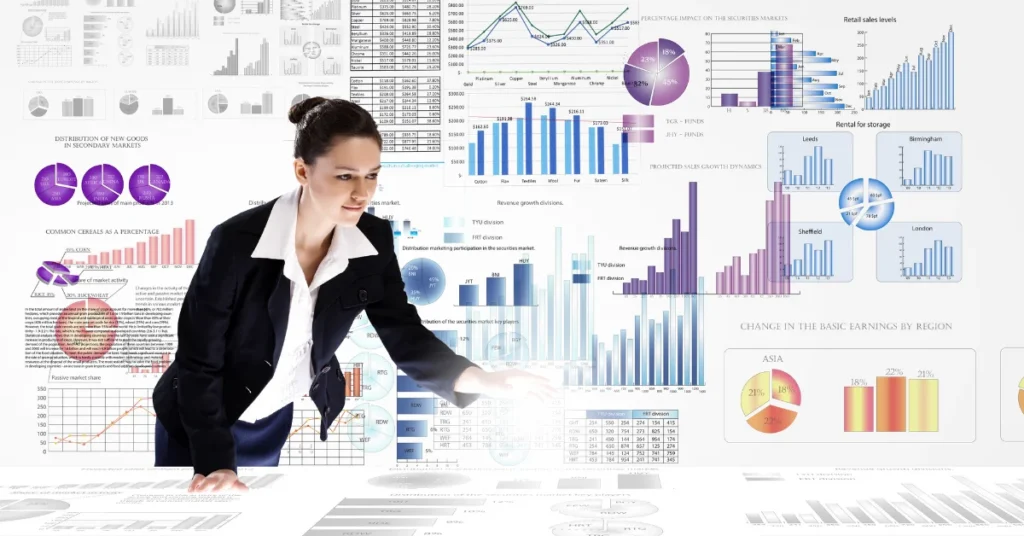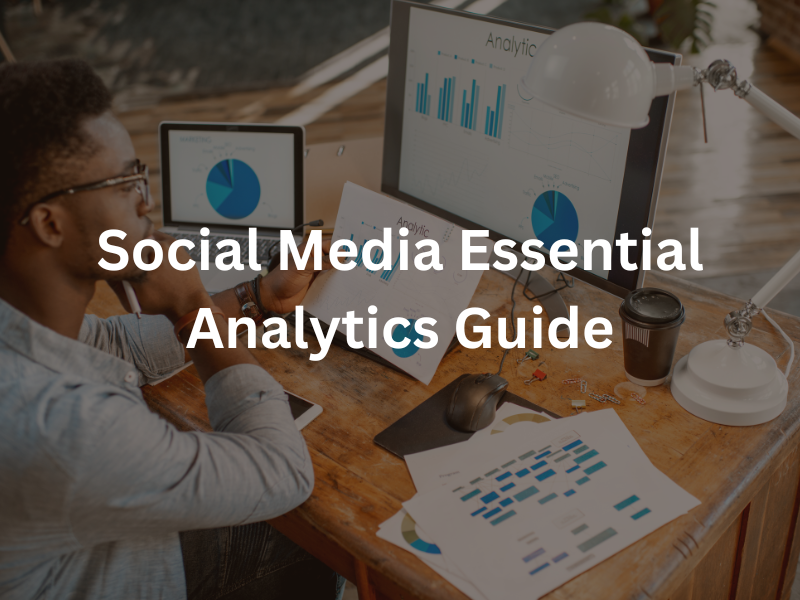Ever wondered if your social media efforts are truly paying off? You’re not alone. In a world where every like, share, and comment can seem like a victory, it’s easy to get caught up in the excitement of numbers without really understanding what they mean. But here’s the kicker—those numbers, when properly analyzed, can be the key to unlocking a successful social media strategy.
Social Media Essential Analytics Guide might sound like a complicated tech term, but it’s really just about getting to know your audience better and figuring out what works best for your brand. This guide will demystify social media analytics, showing you how to track key metrics and improve your social media strategy effectively. Whether you’re a seasoned marketer or just getting started, you’ll find valuable insights to help elevate your social media game.
What is Social Media Analytics?

Social media essential analytics guide might sound like something only tech gurus or big corporations need, but it’s actually a vital tool for anyone serious about making the most of their online presence. At its core, social media analytics is all about collecting and analyzing data from social media platforms to help you understand how your content is performing. This means looking at things like who’s engaging with your posts, what times are most effective for posting, and which types of content resonate best with your audience.
But why does this matter? In today’s digital world, where millions of posts are being shared every minute, it’s not enough to just be active on social media—you need to be strategic. Understanding your analytics can help you pinpoint what’s working, what isn’t, and where you should focus your efforts. It allows you to move from guessing to making informed decisions that drive real results.
In short, social media analytics turns raw data into actionable insights. Whether you’re tracking the rise of a trending hashtag or the success of a recent campaign, these insights are crucial for optimizing your social media strategy and ensuring you’re on the right path to achieving your goals.
Key Social Media Essential Analytics Guide You Need to Track
When it comes to social media analytics, not all metrics are created equal. While it’s easy to get caught up in vanity metrics—those flashy numbers that look good on paper but don’t necessarily translate to success—it’s the meaningful metrics that truly matter. Here are the key social media metrics you need to track to ensure your strategy is on point:

1. Engagement
Engagement metrics show how your audience is interacting with your content. This includes likes, shares, comments, and retweets. High engagement rates indicate that your content resonates with your audience, sparking conversations and encouraging interactions. But it’s not just about quantity—quality matters too. A post with fewer likes but deeper, more thoughtful comments can be more valuable than one with hundreds of likes but no real engagement.
2. Reach and Impressions
Reach refers to the total number of unique users who see your content, while impressions represent the number of times your content is displayed, regardless of whether it was clicked on. While reach helps you understand the size of your audience, impressions give you a sense of how often your content is being seen. Tracking both can help you gauge the effectiveness of your content distribution.
3. Follower Growth Rate
Your follower count isn’t just a vanity metric when tracked over time. The follower growth rate is a more telling statistic, as it shows how quickly you’re gaining or losing followers. A steady increase means your content is drawing interest, while a stagnant or declining rate could be a sign to reevaluate your strategy.
4. Click-Through Rate (CTR)
CTR measures the number of clicks your post receives divided by the number of impressions. This metric is particularly important for driving traffic to your website or landing pages. A high CTR indicates that your content is compelling enough to prompt action from viewers, which is crucial for converting social media engagement into tangible results.
5. Conversion Rate
The conversion rate goes beyond just clicks and engagement; it measures the number of users who take a desired action after clicking through your post. This could be anything from signing up for a newsletter to making a purchase. Monitoring your conversion rate helps you understand how effectively your social media efforts are driving business goals.
By keeping a close eye on these metrics, you can gain valuable insights into what’s working and what needs adjustment. But metrics alone aren’t enough—you also need the right tools to gather and interpret this data.
Top Tools for Social Media Analytics
With so many tools available, choosing the right one for your social media analytics can feel overwhelming. To help you navigate this, here’s a breakdown of some of the top tools that can streamline your analysis and provide you with the insights you need to refine your social media strategy.

1. Google Analytics
While primarily known for website analytics, Google Analytics can also be a powerful tool for tracking social media performance. By setting up UTM parameters on your social media links, you can see exactly how much traffic each post is driving to your website and what those visitors do once they arrive. It’s especially useful for understanding which social channels are contributing the most to your site’s goals, whether that’s sales, sign-ups, or any other conversions.
2. Hootsuite Analytics
Hootsuite is a popular social media management tool that also offers robust analytics features. With Hootsuite Analytics, you can track performance across multiple social media platforms in one place. It allows you to measure metrics like engagement, reach, and follower growth, and provides detailed reports that you can customize based on your needs. This tool is ideal for those managing multiple accounts and needing a comprehensive view of their social media activity.
3. Sprout Social
Sprout Social is another all-in-one social media management platform that excels in analytics. It offers in-depth reports on your social media performance, including engagement, audience demographics, and content performance. What sets Sprout Social apart is its intuitive interface and the ability to create visually appealing reports, making it easier to share insights with your team or clients.
4. Buffer Analytics
Buffer is a user-friendly social media scheduling tool that also offers analytics to help you track your performance. With Buffer Analytics, you can see how your posts are performing across different platforms, identify trends over time, and make data-driven decisions to optimize your social media strategy. It’s especially useful for small businesses and individuals who want a straightforward tool without the complexity of more advanced platforms.
5. Native Platform Analytics
Each social media platform comes with its own built-in analytics tools—Facebook Insights, Twitter Analytics, Instagram Insights, and LinkedIn Analytics, to name a few. These tools offer platform-specific metrics, like post reach, video views, and audience demographics. While they may not offer as comprehensive a view as third-party tools, they’re incredibly useful for diving deep into how your content is performing on each platform individually.
By leveraging these tools, you can gain a comprehensive understanding of your social media performance, making it easier to tweak your strategy and achieve better results. But tools and metrics are only part of the equation—the real value comes from applying these insights to improve your strategy.
How to Use Analytics to Improve Your Social Media Strategy
Now that you’re equipped with the right tools and know which metrics to track, the next step is using this data to enhance your social media strategy. Here’s how you can turn your analytics into actionable insights:

1. Identifying Patterns and Trends
Start by looking for patterns in your data. Are there certain types of posts that consistently perform well? Do you notice higher engagement on specific days or times? Identifying these trends can help you refine your content strategy. For example, if video posts get more engagement, you might consider incorporating more video content into your schedule. If posts on Wednesdays perform better, that might be the ideal day for important announcements or new content.
2. Adjusting Content Based on Performance Data
Analytics allow you to see which content resonates most with your audience, enabling you to tailor your strategy accordingly. If you notice that posts with behind-the-scenes content receive more comments, consider sharing more of that type of content. On the other hand, if certain posts are underperforming, you may want to rethink the content or format, or even discontinue that approach altogether.
3. Experimenting with Posting Times and Content Formats
Social media is constantly evolving, and what worked last month may not work today. Use your analytics to experiment with different posting times, content formats (such as images, videos, or infographics), and even captions. A/B testing can be particularly useful here—try posting the same content at different times or with different calls to action, and see which performs better. This iterative approach allows you to continuously refine your strategy.
4. Setting SMART Goals Using Analytics
SMART goals (Specific, Measurable, Achievable, Relevant, and Time-bound) are a framework that can help you turn your social media strategy into concrete objectives. Use your analytics to set realistic benchmarks. For instance, if your current average engagement rate is 5%, you might set a goal to increase it to 7% over the next three months. By grounding your goals in data, you ensure they are both ambitious and achievable.
By consistently applying these strategies, your social media efforts will become more targeted and effective. Remember, the key to success is not just collecting data, but using it to inform and evolve your approach. However, be mindful of common mistakes that can derail even the most well-intentioned strategy.
Common Pitfalls in Social Media Analytics and How to Avoid Them
Even with the best tools and strategies in place, it’s easy to fall into certain traps when analyzing your social media data. Here are some common pitfalls and tips on how to avoid them:

1. Misinterpreting Data
One of the biggest risks in social media analytics is misinterpreting the data. It’s tempting to take numbers at face value, but without proper context, they can be misleading. For example, a sudden spike in followers might seem like a win, but if those new followers aren’t engaging with your content, they might not be as valuable as you think. Always dig deeper to understand the “why” behind the numbers, and consider qualitative factors like sentiment analysis or audience feedback.
2. Focusing on Vanity Metrics
Vanity metrics are those numbers that look impressive but don’t necessarily correlate with meaningful success. Think of follower counts, likes, and impressions—they’re nice to have, but they don’t always tell the whole story. Instead, prioritize metrics that align with your business goals, such as conversion rates, click-through rates, or engagement levels that indicate real interaction with your content.
3. Ignoring Qualitative Data
Quantitative data—numbers and statistics—is important, but don’t overlook qualitative data, like comments, reviews, and direct messages. These interactions can provide deeper insights into how your audience feels about your brand, what they like or dislike, and what they want to see more of. Incorporating this feedback into your strategy can lead to a more engaged and loyal audience.
4. Failing to Adapt Strategy Based on Analytics
Analytics should be a dynamic part of your strategy, not something you check once and forget about. One common mistake is sticking to a strategy that used to work but is no longer effective. Social media is constantly changing, and so should your approach. Regularly review your analytics and be prepared to pivot when needed—whether that means trying new content formats, changing your posting schedule, or even rethinking your overall strategy.
By being aware of these pitfalls and actively working to avoid them, you can make more informed decisions that will lead to sustained success in your social media efforts. The final piece of the puzzle is looking ahead to the future of social media analytics.
The Future of Social Media Analytics
Social media analytics is constantly evolving, and staying ahead of the curve is crucial for maintaining a competitive edge. As technology advances, here are some trends and developments to watch out for:

1. The Role of AI and Machine Learning
Artificial intelligence (AI) and machine learning are already making significant impacts on social media analytics, and their influence is only expected to grow. These technologies can analyze vast amounts of data faster and more accurately than humans ever could. AI can help predict trends, identify sentiment in real-time, and even automate reporting. For example, tools like IBM Watson Analytics can provide deep insights into your audience’s behavior, helping you tailor your content strategy more precisely.
2. Enhanced Predictive Analytics
Predictive analytics is about more than just understanding what has happened; it’s about forecasting what will happen next. By analyzing past data, predictive models can help you anticipate audience behavior, such as which posts are likely to perform well or when your followers are most active. This allows you to be more proactive in your strategy, optimizing content before it even goes live.
3. Integration with Other Marketing Channels
In the future, expect to see deeper integration between social media analytics and other marketing channels, like email, SEO, and paid advertising. This will provide a more holistic view of your marketing efforts, helping you understand how different channels work together to drive conversions. For instance, you might track how social media interactions influence email sign-ups or how social media ads contribute to your overall sales funnel.
4. Real-Time Analytics and Dashboards
As the pace of social media accelerates, real-time analytics will become increasingly important. Brands need to respond quickly to trends, crises, or opportunities, and real-time dashboards will enable them to do so. These tools allow you to monitor your social media performance live, giving you the ability to adjust your strategy on the fly, whether it’s jumping on a trending hashtag or addressing negative feedback immediately.
5. Privacy and Ethical Considerations
As social media platforms and analytics tools become more powerful, so too will the focus on data privacy and ethical considerations. Users are becoming more aware of how their data is used, and regulations like GDPR are setting stricter guidelines for data collection and analysis. In the future, social media analytics will need to balance the need for insights with the growing demand for transparency and ethical data practices.
By staying informed about these trends, you can position your brand to not only keep up with the changes but also to leverage them to your advantage. The future of social media analytics is bright, offering more precise, actionable insights than ever before.
Conclusion
Social media analytics might seem complex, but when broken down, it’s really about understanding your audience and refining your strategy to meet their needs. From tracking key metrics to leveraging advanced tools, and staying ahead of future trends, these insights will help you take your social media game to the next level.
Remember, the goal isn’t just to gather data—it’s to use that data to make smarter decisions that lead to better results. So why wait? Start applying these tips today and watch your social media strategy soar.













